tags: Red-tailed Black Cockatoo, Calyptorhynchus banksii, birds, mystery bird, bird ID quiz
[Mystery bird] Red-tailed Black Cockatoo, Calyptorhynchus banksii, also known as Bank's Black Cockatoo, photographed at Walgett, New South Wales, Australia. [I will identify this bird for you in 48 hours]
Image: Steve Duncan, 18 August 2009 [larger view].
Nikon D200 w/ Nikkor 300mm f/4.
Please name at least one field mark that supports your identification.
- Log in to post comments


I think we had this one (the same individual, even) a few weeks back and I debated whether it was the eastern subspecies of the Glossy Black (Calyptorhynchus lathami lathami), found from southeastern Queensland through New South Wales to eastern Victoria, or the largest subspecies of the Red-tailed Black (Calyptorhynchus banksii banksii) found in northern New South Wales...
With support from some of our Aussie's on the spot, the gold speckling, barred tail, range, and field observations of yellow in the tail varying within individual females, seemed to indicate this to be a female Samueli's Red-tailed Black Cockatoo, Calyptorhynchus banksii samueli but I remain unconvinced!
I know the obvious thing will be to settle on the initial identification in early October (especially if this is the same individual) but this still looks to me to be a female Glossy Black Cockatoo, Calyptorhynchus lathami lathami, as photographed below:
female Glossy Black at Australia Zoo
The bird is a female red-tailed black cockatoo. The female has black bars on the red streaks in the tailfeathers and also has no red patches on either side of the neck (in fact if you look carefully you'll see small yellow spots). It's a pity we can't see the extremities of the wings; there should be some red markings there as well (well, at least on the male). This is not the threatened "glossy black (lathami)" (which looks more a mousy brown, has lateral yellow spots, and if there were some reference to size, much smaller than a red-tail black). The red-tail black is also a glossy (gee, what black cockatoo isn't glossy) but is 'banksii', not 'lathami'. (http://www.glossyblack.org.au/correct_id.html) The yellow-tailed black cockatoo is very similar in size and color except - well, it's got yellow patches and streaks.
I'd just like to point out that there are several varieties of red-tailed black with varying degrees of yellow markings (I can't find any decent photos on the 'net showing the variety of birds), but I still see no reason to classify this as a glossy black.
Hmm... apparently this bird is listed as "critically endangered":
http://www.environment.nsw.gov.au/determinations/redtailedblackcocatooc…
Despite the threat classification, I see these birds in large numbers over a very large area - of course numbers aren't the only indicator since these birds are known to live over 80 years and without a large enough breeding population you can have a large non-reproducing population.
@Mad,
I concede defeat, you are indeed correct, and the Glossy Black Conservancy page was a great resource, thank you!
As this photo is from Walgett in northern New South Wales, would you think this was the nominate subspecies C. b. banksii (found in Queensland and, rarely, in far northern New South Wales) or the slightly smaller C. b. samuelii (the upper Darling River system in Western New South Wales)?
Walgett sits on the Barwon-Darling River system where 1,600 samuelii were reported in November 2008.
It may be the bird we discussed previously. This remains a problematic ID as far as I can see (from HANZAB)
Male Red-tailed ~3 years old and immature Glossy-black still both look possible.
Diagnosis should be possible from bill size/shape & tail (proportional) length. Bill suggests Red-tailed to me but tail proportion suggests Glossy-black to me.
This doesn't come up in the field. The 2 species have little overlap in range/habitat. Separation is easy from call and they usual occur in mono-specific flocks with easy-to-ID individuals present.
This subspecies mentioned as critically-threatened in NSW above is C. b. banksii. Walgett is 500+km from C. b. banksii range. It is within C. b. samuellii range as David indicates. You can theoretically separate the subspecies by bill shape/size
C. b. banksii. is not critically-threatened overall - its fairly common in northern Queenland. Other ssp are in more trouble.
Andrew,
The first photo below is what started me wondering whether what we have here really is a female Red-tailed Cockatoo or not (or an immature female Glossy?). I'm not sure how much variation there is within species or between subspecies, but it seems that here the similarities can be explained as shared within the genus Calyptorhynchus but not certain at the species level.
The second photo is another look at what I think was probably the same individual (assuming Steve shot a series) which might give you another take on tail proportion.
female Red-Tailed Cockatoo (in a Bengal Almond, Terminalia catappa), Queensland
Bank's Black Cockatoo [?], New South Wales
David, as far as I can tell females always have, and should should in a view like this yellow-orange in its tail.
I think it is a Red-tailed BC but I can't convince myself that it can't be an imm. Glossy-black.